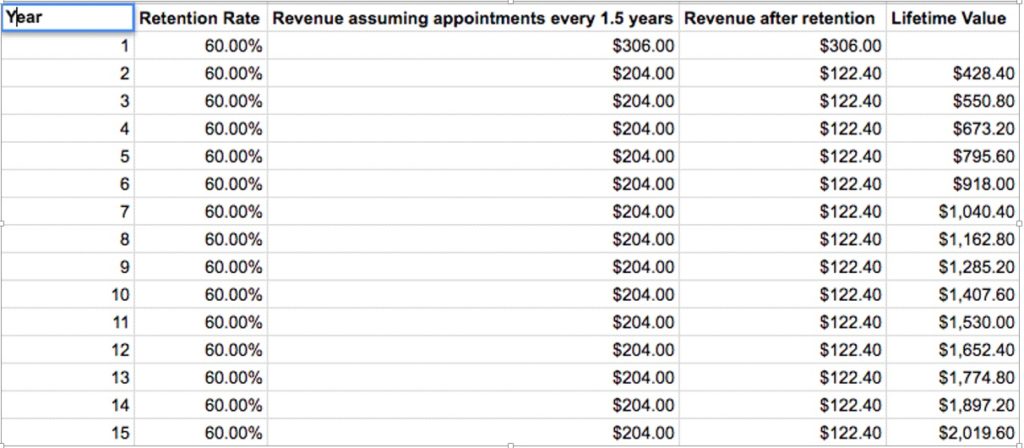By Nancy Rausman,
Managing Editor, EyeCarePro

Jan. 24, 2018
Are you focused on the right results when it comes to measuring marketing success for your practice? Web site traffic, clicks, likes, page-one search ranking? These measures are all important to your marketing efforts, but they are only half the story. The real measure of success is your return on investment (ROI), which comes down to the revenue your marketing generates by adding new patients, appointments, or selling products and services.
There are two calculations that can help to determine a meaningful ROI: marketing conversion rate and patient retention rate. The conversion rate is a short-term rate that can be measured by how many appointments your marketing (such as your web site or a specific marketing campaign) brought in. It tells you how good of a job your site, ad or messaging is doing at converting visitors to paying customers. This rate can be improved in many ways, including stronger calls to action, more compelling copy or imagery, and modifying your target audience when advertising.
Calculate & Track Conversion Rate
You get your conversion rate by the following equation: The number of visitors that convert into appointments divided by the number of total visitors to web assets. The average conversion rate is 3-4 percent. We compute that 75 percent of site visitors are new visitors. Yes, established patients repeatedly go online to look up a practice’s phone number or location, but that search is satisfied by the Google listing, and they stop short of visiting the site itself. So, a practice can either use the average above or can look directly in Google Analytics (or their web marketing statistics if they work with a service) at their “new user rate” and account for that difference when figuring out the conversion rate.
The easiest way to track conversation rate is to create a separate call-tracking number for each channel and campaign (print ads, landing pages, e-mails, etc.) that you produce. You can easily set up a call tracking number with a service like Twilio, which costs only $1 a month. At the very least, you will know how many calls are coming from the various channels and an estimate of whether they result in an appointment or sale.
Conversion rate is a way to determine the effectiveness of your marketing strategy, and should be used as a gauge to understand your audience and what motivates them in order to fine-tune your messaging.
However, conversion rate can be short-sighted in the big picture of your marketing success, because marketing isn’t just for new patient appointments; it is for your existing patients, as well.
Calculate & Track Patient Retention Rate
If you are working hard to get new patients, but not investing in keeping them for the long term, you are running your practice like a mouse in a wheel. What will really have an impact in the long term is the lifetime value of a new patient, or your practice’s patient retention rate.
In general, a patient appointment generates $306 in total revenue (MBA Key Metrics). While a new patient might spend this few hundred dollars at the first visit, if they schedule every year and a half for 15 years they can bring in upwards of $2,000 to the practice. And that doesn’t include up-selling and specialty treatments, or possibility that they bring in family members and referrals of additional patients.
Calculating retention rate can be time consuming, but it is well worth it. We asked one of our clients with a particularly high retention rate (they shoot for 100 percent!), who said they hand track it. Each month they cross reference the full exams they perform with the year before, and follow-up with all of those they did not see.
According to the doctor, calculating the patient retention rate is, “time consuming, but it pays for itself 10-fold.” Think about it in terms of lost revenue. The chart below demonstrates the lifetime revenue of a new patient based on a 60 percentage rate and an appointment scheduled every 1.5 years. Therefore, every new patient that you lose is a loss of at least that potential $2,000. If you have a strategy in place to retain those patients, it can clearly pay off.

METHODOLOGY: In the revenue model above, every patient seen generates $306 in revenue, on average. However, patients only come back, on average, 1.5 years. So in year two, a patient generates $204 in revenue. Since not all new patients come back, the retention rate is estimated at 60 percent. So the real revenue from that new patient after year one is $122. Assuming that one new patient over the next 15 years will generate $122 per year or about $2,000 in total, as a lifetime patient of your practice rather than a competitor’s.
Value of Marketing Depends on Increasing Patient Value
Ultimately, ROI is dependent on the value of your patients–how much revenue they are bringing in now and in the future.
Here are a few ways you can increase your patient value (increasing the average patient spend to be over $306):

Advertising like this reaches out to mothers, showing them what your practice can do for their whole family.
Focus your marketing efforts on mothers. Ultimately, mothers have influence over the whole family, including children and husbands. If you do a good job of creating loyalty with the mother, chances are you will snag the whole family.
Upsell eyewear. Most practices offer services that every patient needs, but they don’t always do a good job at selling them. This can include dry eye treatment, computer vision and blue light protection, sunglasses, presbyopia solutions, multifocal contact lenses, myopia control. These are all sources of additional revenue that can increase your patient value.
Specialize. We have clients that have increased their average patient value to $600-$750 a month by specializing in high-revenue services such as low vision, ortho-k, or scleral lenses (which are often not covered by insurance). By focusing on filling their schedule with appointments that bring in $3,000 in cash, rather than a $50 insurance covered eye exam, they are increasing their revenue per patient. Specialties like dry eye or myopia are easy, low cost, and require minimal training and equipment. Some of our practices also specialize in high-end frames, and market this branding heavily.
Engage existing patients. Establish an active presence with your community on Facebook, Snapchat, Instagram or wherever your clientele “hang out.” Create messaging both in person and online to encourage an increase in the frequency of appointments. Focus on timely campaigns such as the end-of-the-year “Use it or lose it.” Send an occasional e-mail or direct mail piece to update patients about news, promotions or events. Staying top of mind, and maintaining a relationship with your existing clients, will increase patient loyalty and retention.
Offer a referral incentive. Entice your patients to organically bring in more new patients by offering an incentive program. It’s a win win.
Project Benefits of Social Media
Facebook and social media ROI is more intangible, but when you are thinking in terms of the big marketing picture, every impression, connection and share enhances your name recognition and your relationship with your patients. While there may not be a monetary amount, you are adding value, creating “face time” and keeping your practice in mind. This definitely influences a feeling of loyalty and increases patient retention, and over the long term, can increase patient value, too. Google reviews are another long-term play that can influence future sales and referrals.
Calculate How Marketing Impacts Practice Worth
Another amount to keep in mind is your practice worth. If you put more into investing in building up your practice through your online presence and bringing in more long-term patients, you will likely be able to sell your practice for more when the time comes.
Think Long-Term
More than a mere marketing strategy, your practice approach should focus on two equally important aspects, new patient acquisition and a superior patient experience. These results should be tracked and measured as much as possible to see which strategies work, and which need to be modified. When you think in terms of long term ROI, spending $100 dollars now on a new patient with a potential lifetime revenue of $2,000 is definitely well worth it.
 Nancy Rausman is managing editor at EyeCarePro. Nancy is responsible for providing ECPs with educational content that helps them advance their practices through technology, management strategies and digital marketing. EyeCarePro is one of the leading providers of online marketing and practice improvement services in the industry. EyeCarePro serves both industry and practices and is the only company of its kind solely focused on the optometric space. To contact: nancy@eyecarepro.net
Nancy Rausman is managing editor at EyeCarePro. Nancy is responsible for providing ECPs with educational content that helps them advance their practices through technology, management strategies and digital marketing. EyeCarePro is one of the leading providers of online marketing and practice improvement services in the industry. EyeCarePro serves both industry and practices and is the only company of its kind solely focused on the optometric space. To contact: nancy@eyecarepro.net























